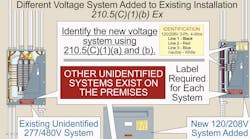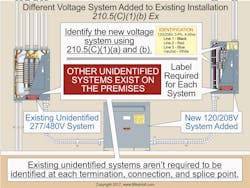Stumped by the Code? Requirements for the Identification of Branch-Circuit Conductors
All questions and answers are based on the 2017 NEC.
Underlined text indicates a change in the rules for the 2017 NEC.
Q. What does the Code require for the identification of branch-circuit conductors?
A. Section 210.5 lists the following requirements:
(A) Neutral conductor. The neutral conductor of a branch circuit must be identified in accordance with 200.6.
(B) Equipment grounding conductor. Equipment grounding conductors (EGCs) can be bare, covered, or insulated. Insulated equipment grounding conductors size 6 AWG and smaller must have a continuous outer finish either green or green with one or more yellow stripes [250.119]. On EGCs 4 AWG and larger, insulation can be permanently re-identified with green marking at the time of installation at every point where the conductor is accessible [250.119(A)].
(C) Identification of ungrounded conductors. Ungrounded circuit conductors must be identified as follows:
(1) More than one voltage system. Where the premises wiring system has branch circuits supplied from more than one nominal voltage system, each ungrounded conductor must be identified by phase and system at all termination, connection, and splice points as follows:
(a) Means of identification. Identification can be by color coding, marking tape, tagging, or other means approved by the authority having jurisdiction.
(b) Posting of branch-circuit identification. The method of identification must be readily available or permanently posted at each branch‑circuit panelboard, not be handwritten, and be of sufficient durability to withstand the environment involved.
Exception: Where a different voltage system is added to an existing installation, branch circuit identification is required for the new voltage system. Existing unidentified systems aren’t required to be identified at each termination, connection, and splice point in compliance with 210.5(C)(1)(a) and (b). Each voltage system distribution equipment must have a label with the words “other unidentified systems exist on the premises.” (See Figure)
When a premises has more than one voltage system supplying branch circuits, the ungrounded conductors must be identified by phase and system. This can be done by permanently posting an identification legend that describes the method used, such as color-coded marking tape or color-coded insulation. Conductors with insulation that’s green or green with one or more yellow stripes can’t be used for an ungrounded or neutral conductor [250.119].
Although the NEC doesn’t require a specific color code for ungrounded conductors, electricians often use the following color system for power and lighting conductor identification:
- 120/240V, single-phase — black, red, and white
- 120/208V, 3-phase — black, red, blue, and white
- 120/240V, 3-phase — black, orange, blue, and white
- 277/480V, 3-phase — brown, orange, yellow, and gray; or, brown, purple, yellow, and gray
Q. What is the Code definition of “Building”?
A. The NEC defines a “building” in Art. 100 as “A structure that stands alone or is separated from adjoining structures by fire walls.
These materials are provided to us by Mike Holt Enterprises in Leesburg, Fla. To view Code training materials offered by this company, visit www.mikeholt.com/code.





